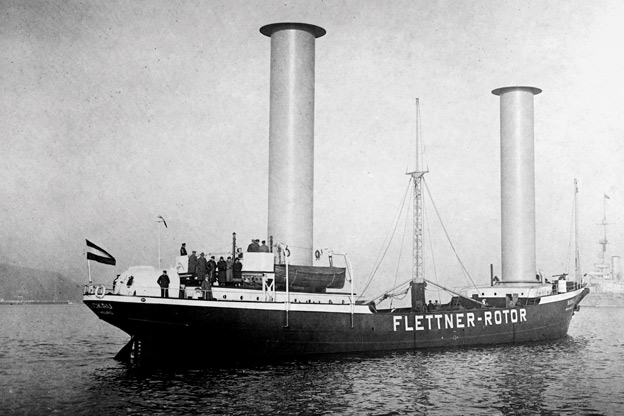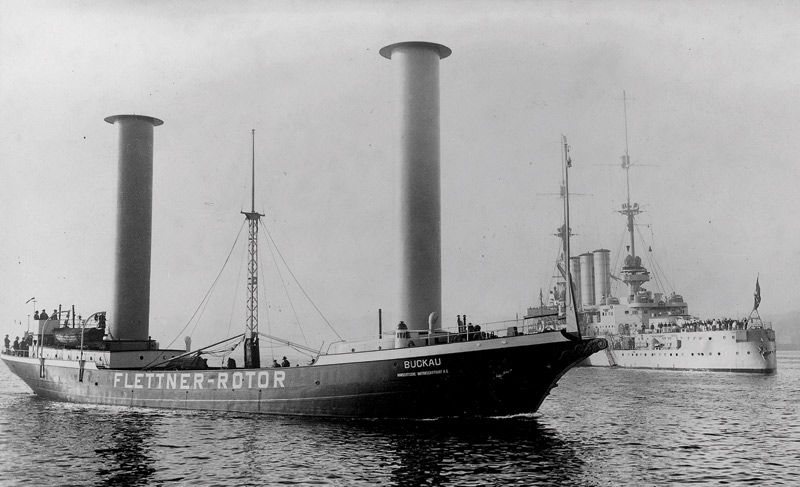A nearly century-old concept might transform wind power
// By Peter Marsh
 Green is King was the title of my last article in the Northwest Yachting‘s February 2017 issue, describing the first hybrid ferry on the West Coast carrying trailers in-between the mainland of British Columbia and central Vancouver Island. At high-speed, the ferry burns liquid natural gas (LNG) in its diesel engines to generate 9,000 horsepower, while at low speed near the shore, a bank of lithium-ion Corvus batteries made in B.C drives the ferry. Hybrid ship designs like this were pioneered in Scandinavia where ecological hydro-power has long been the standard for utilities. The public demand for clean power use has led to the introduction of hybrid propulsion in several new ferries and short-haul cargo vessels. I expected this to be the gold standard for green shipping until some new technology like the fuel cell was perfected several years from now.
Green is King was the title of my last article in the Northwest Yachting‘s February 2017 issue, describing the first hybrid ferry on the West Coast carrying trailers in-between the mainland of British Columbia and central Vancouver Island. At high-speed, the ferry burns liquid natural gas (LNG) in its diesel engines to generate 9,000 horsepower, while at low speed near the shore, a bank of lithium-ion Corvus batteries made in B.C drives the ferry. Hybrid ship designs like this were pioneered in Scandinavia where ecological hydro-power has long been the standard for utilities. The public demand for clean power use has led to the introduction of hybrid propulsion in several new ferries and short-haul cargo vessels. I expected this to be the gold standard for green shipping until some new technology like the fuel cell was perfected several years from now.
Boy, was I wrong! On January 25, a news release from Viking Cruises of Helsinki, Finland really upped the ante in the green ship stakes. It announced that the M/S Viking Grace, a LNG-fueled cruise ferry and one of the most environmentally-friendly cruise ships in the world, will be adding “renewable power” to its credentials and its marketing, thanks to the addition of a Norsepower Rotor Sail. When it resumes cruising in 2018 through the pristine archipelago between Turku, Finland and Stockholm, Sweden, Viking Grace will be the third modern ship and first passenger vessel in the world to harness the wind via a simple law of physics known as the “Magnus Effect.” This radical concept in marine technology may sound like a “spin off” (forgive my pun) from advanced aeronautical research, but it is actually something we are all familiar with. The Magnus Effect causes balls to rise when hit with backspin, creating a surprising amount of lift in sports from golf to soccer.
The Magnus Effect Mystery
When the wind is on the beam (60-130 degrees) and reaches a predetermined strength, the 75-foot high and 12-foot diameter tubular Norsepower rotor mast automatically begins spinning. This extracts lift from the wind to supplement the ship’s engines and reduce its emissions and fuel cost. This effect is based on research that began in the 1600s when Sir Isaac Newton observed the unexpected motion of tennis balls.
A century later, the object in motion was the musket ball and the scientist was another Englishman named Benjamin Robins. He tried to predict the range of the British Army’s standard musket in winds of different strength and direction. In the 1860s, this problem was carefully studied and described by Heinrich Gustav Magnus, a German professor and a scientific genius who actually made far more important discoveries in chemistry electro-magnetism. Sadly, he is only remembered for some minor experiments involving the trajectory of spinning iron balls, which have fascinated nautical inventors ever since!
Anton Flettner
Other than making guns more accurate, none of these learned gentlemen seemed to have any more constructive uses for the rotor effect. But Anton Flettner (1885-1961) was a German-born engineer who came from a long line of seafaring men. His first dreams of invention began when, as a boy, he made a voyage to Australia before the mast in his father’s ships.
As a young engineer at Zeppelin Works he made a close practical study of aerodynamics. He went on to become director of the Institute for Aero and Hydro-Dynamics in Amsterdam. At the end of World War I, the age of commercial sail was practically dead. Germany’s great fleet of steel square riggers built to carry nitrates from the Chilean desert around Cape Horn was stranded in ports all round the Americas and could no longer compete with the latest steam ships. This was seen as a cultural disaster by traditional seafarers, and many retired captains pondered ways to modernize sailing ship and preserve these iconic symbols of a bygone era. Flettner himself was inspired to try a brief experiment with a metal sail around 1920. It almost ended in disaster, but he was widely quoted at the time stating it was far more efficient than a fabric sail—as the last America’s Cup clearly demonstrated!
Now his thinking led him in a completely opposite direction—away from sails entirely. Some colleagues were investigating the Magnus Effect in aircraft, and he was intrigued by the idea of applying the concept to ships. He took the next logical step and used the institute’s wind tunnel to study this phenomenon. He proved that a vacuum was created ahead of the spinning cylinder and an area of high pressure behind, resulting in forward propulsion. His tests appeared to show that a rotating cylinder could extract up to 15 times as much energy from the wind as the same area of sail.
The Amazing Rotor Ship
In 1924, he successfully tested a prototype of his rotor mast on a small yacht and visualized a future where ships would be powered by rotor power. So he took the ambitious step of obtaining the funds to acquire a 156-foot schooner to fully demonstrate the ability of his discovery. If you think wingsails are revolutionary today, imagine what mariners must have felt when they saw Flettner replacing the two masts and rigging with two hollow cylindrical towers!

The cylinders were over 60 feet high and 10 feet in diameter, made of riveted and rolled sheet steel, and sat on bearings so they could be rotated. Not by a few degrees like a wingsail, but at 120 rpm by small electric motors driven by a 50-horsepower diesel engine! The total weight of the complete mechanism—towers, engine, and motors—was given as 15,000 pounds, just one-fifth the weight of the discarded sails and rigging. This must have been a dramatic sight in a time when traditional trading ketches still sailed on the Baltic Sea and most aircraft were bi-planes.
The next year, 1926, Flettner renamed his ship the Buckau and successfully crossed the Atlantic to South America. According to the New York Times, when the rotor ship arrived in New York, “He received a welcome such as is accorded only to celebrities of the very first rank. Here was a man who had truly revolutionized the art of harnessing the wind, who had replaced a device, used in essentially unaltered form for thousands of years, the canvas sail, by a modern machine, ten times as efficient and requiring no crew for handling.”
No less a mind than Albert Einstein pronounced the rotor principle of great practical importance. Popular Science Monthly jumped on the bandwagon with more praise for Flettner and his invention. “Blue Coal” was now the slogan the inventor used for his wind machine that would harness wind-fuel for the good of mankind. “It is wonderfully cheap,” he tells us, “and it is available to the world in billions of horsepower.”
Flettner claimed that each tower produced 500 horsepower of thrust and that this was safer because “reefing” was accomplished by simply slowing the spinning. Two students in naval architecture at the Massachusetts Institute of Technology were so impressed they decided to build their own rotor themselves. They managed to complete the new rig from salvaged parts and stepped it on an abandoned 30-foot navy cutter. No reports exist on how it really sailed and consumed fuel—a common feature of the coverage of Flettner’s “miraculous discovery.”
The German government showed their faith in Flettner by building a 3,000-ton, three-rotor passenger ship, the Barbara. The project ended and the story stopped there with no explanation. Some skeptical marine engineer must have found the fuel log and discovered the rotors were a net loss—using more fuel than they were supposedly saving. The whole episode seems to have been viewed as a useful but unsuccessful experiment; the rotors were scrapped, the ships returned to their former roles, and the rotor ship seemed as dead as the clipper ship. That would appear to be the end of the matter. I wonder if the Germans have an expression for our “No such thing as a free lunch”? But in Berlin, one minister had predicted that “the time is not far off when forests of windmills will be centralized in various parts of the country to supply power and light to nearby cities and factories.” Unfortunately, history intervened in Germany, but this prediction really came true in the 21st century.